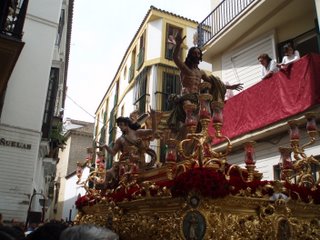
Way back when studying abroad was just a dream and I was choosing between five different programs and thirteen different cities, Sevilla sounded livable because of its friendliness to students, its moderate size, and its cultural and religious history – a mix of Muslims, Jews, and of course, Catholics. I heard stories from a friend who had studied in Spain and dated a nice Jewish Spaniard, and from a teaching assistant who had lived there, and was sold. Maybe Spain isn’t as infernally hot or as devoutly Catholic as everyone says.
Here I am three months into my stay. It was cold for awhile but now the digital thermometers on the farmacia signs around town regularly register between 25 and 30 – in April. It’s the middle of Passover and I’ve eaten a thick, fluffy baguette for breakfast and lunch and this morning I followed Jesus and the Virgin Mary around town in honor of Domingo de la Resurrección (Easter). I went to my program activity office at the beginning to inquire about a synagogue and was told there are approximately five members, the phone number is disconnected, and services are held in an unlabeled building on a rather shady street. I didn’t bother, and I didn’t really notice any other type of religion besides the tiny grey churches on every other street until this week – Semana Santa.
Understandably Saint’s Week, the week that begins with Palm Sunday and ends with Easter Sunday and mourns Jesus’ crucifixion and celebrates his subsequent resurrection, is a big deal for a Catholic country. Even if history has left a few ancient mosques in Andalucía and three synagogues in Spain it doesn’t change the fact that los Reyes Catolicos revamped Catholicism in the late 1400s while expelling everything else, and Spain hasn’t been religiously diverse since. (The very same Catholic royals, Ferdinand and Isabella, sent Cristobal Colon/Christopher Colombus, whose remains are in Seville’s catedral, to Asia in 1492 and he ended up founding America but never knew it.) Religious unity is something that the obviously U.S. lacks, and it seems kind of nice, because besides country pride and region pride, Spaniards have a country-wide sense of religious unity and tradition in that comes from Catholicism.
The traditional aspect of the Semana Santa celebration in Sevilla is refreshingly ancient and beautiful. Parades of pointy-hooded nazarenos, cross-carrying barefoot penitentes, and elaborate saint’s week scenes float through the city thanks to an army of 20-40 costaleros who hold the huge heavy floats from underneath on the backs of their necks in tune with the mournful whining music… Catholicism aside, it’s amazing, breathtaking, and solemn. But this morning as I was pushing through a crowd trying to get to a good spot from which to view the final procession of the week, I realized that it’s still Passover, I was wearing a Star of David, and following a float that depicted Jesus with bloody hands and feet and a gold crown, ascending up to heaven.
It’s hard to tell how religious Spaniards actually are. My señora for one doesn’t ever go to church, but she does pray each night before bed and her room is decorated with a picture of Jesus above her bed. The rest of the Sevillian and Spanish tourist population seems to turn up on the streets during Semana Santa en mass at all hours of the day and night to view these processions. Some choose to be band-members, costeleros, nazarenos, and penitentes for their own church’s processions. Everyone dresses up in suits and skirts or dresses, and Spanish women dress in black lace on Friday as a sign of mourning. Some buy seats for 200-500€ each on the parade route, or inherit bleacher seats. Kids get involved too, some donning the nazareno costumes, and some running through the processions in their little spring dresses or suits asking for candy and pictures of that particular church’s Virgin Mary. Still, everyone seems to go out for drinks and tapas as usual.
I’m not actually going anywhere with this. Out of all the cities I’ve visited in Spain, by now including Granada, Jerez de la Frontera, Cadiz, Malaga, Utrera, Madrid, Toledo, San Lorenzo del Escorial, I still like Sevilla the best. Despite the Catholicism, all the Americans, the impending heat, the walking, and everything else I complain about, it’s pretty near perfect. I think my mom agrees.

At the Alcazar... a sight in Seville i'd actually never seen before. It's almost in another dimension, so hidden behind houses and the depths of the old Jewish quarter that you never realize it's there, or that it's so big and beautiful.

2 comments:
Lindsey, I loved your article and the beautiful picture of you and your mother. I am proud of you and that you wear your Star of David.
Love
Grandma Miller
Seville was beautiful. I wish I could go again.
I have done some research on Jews in Spain. The Jewish population of Spain numbers 14,000 out of a total population of 39.1 million. The main Jewish centers are Madrid (3,500) and Barcelona (3,500). Smaller communities are located in other cities and towns, notably Málaga, as well as Ceuta and Melilla in Spanish North Africa. The decedents of the Jews that were expelled in 1492 are Sephardic Jews. Most of the Jews in Spain today are Ashkenazi Jews from Germany, moving there following WWII.
Post a Comment